Laptop Mag Verdict
The Motorola Atix HD's vivid display and high-quality design make this Android phone a very good value.
Pros
- +
Bright and colorful HD display
- +
Sturdy design
- +
Helpful interface tweaks to Android
- +
Loud speaker
- +
Fast 4G LTE performance
Cons
- -
Relatively short battery life
- -
Menu buttons make display smaller than 4.5 inches
Why you can trust Laptop Mag
Promising equal parts beauty and brawn, the $99 Motorola Atrix HD has the makings of one of the best value-priced smartphones around. Not only is this sequel for AT&T made tough thanks to a Kevlar-infused design, it boasts an HD display enhanced with ColorBoost technology to make photos and videos pop. Motorola also added a few unique twists to Ice Cream Sandwich in an attempt to make Android more approachable while ditching compatibility with its laptop dock. Is this Atrix a winner?
[sc:video id="R2bTVqcTqLdTc8eis6SCI19Au7bSgGm9" width="640" height="410"]
Design
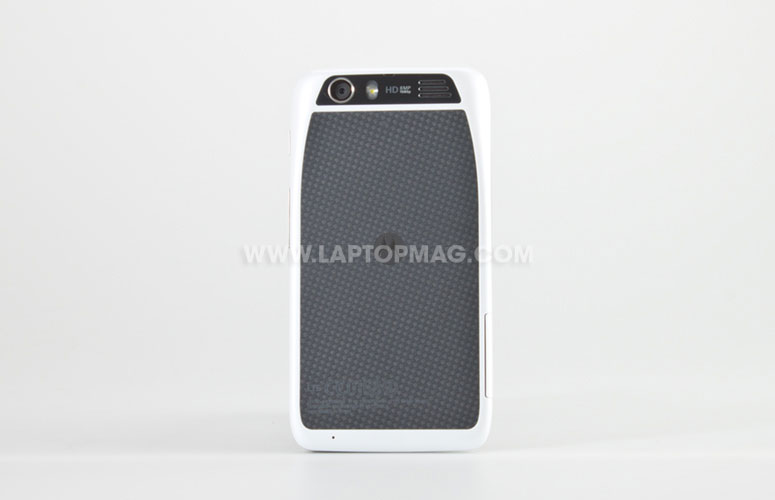
Click to EnlargeThe Atrix HD is one phone that you should feel comfortable knocking around. As with the Droid RAZR line, Motorola graced this handset with a Kevlar-reinforced back, which gives it a durable feel. You should also have no problem using this phone by the pool or the beach, as there's a nano coating that acts as a splash guard. Our model came in white, but you can also get this phone in titanium.
The Atrix HD is slim at its thinnest point (0.33 inches), but it gets considerably thicker toward the top, which is where you'll find the 8-MP camera on a protruding bump along with the speaker. The very top of the device houses the microphone, microUSB and microHDMI ports. A nicely textured silver power button and two volume buttons line the left side, while a small door on the left hides the SIM Card and microSD Card slots. Note that the battery is not removable.
Unlike other Ice Cream Sandwich phones we've tested, Motorola eschews capacitive and physical buttons beneath the screen on the Atrix HD. Instead, it opted for a cleaner, more Nexus-like approach by putting the Home, Back and Recent App buttons at the bottom of the screen. We do like that all of these buttons change orientation when you flip the phone around, but this area takes up valuable real estate. (See Display section below.)
Weighing 4.9 ounces and measuring 5.3 inches tall by 2.8 inches wide, the Atrix HD is about the same size, but heavier than the 4.7-ounce Samsung Galaxy S III, despite featuring a smaller display (4.5 inches versus 4.8 inches). There's a lot of empty space around the screen, including a large AT&T logo beneath the LCD. Still, Motorola's device is lighter and slimmer than the Sony Xperia ion (0.46 inches thick, 5.3 ounces).
Display
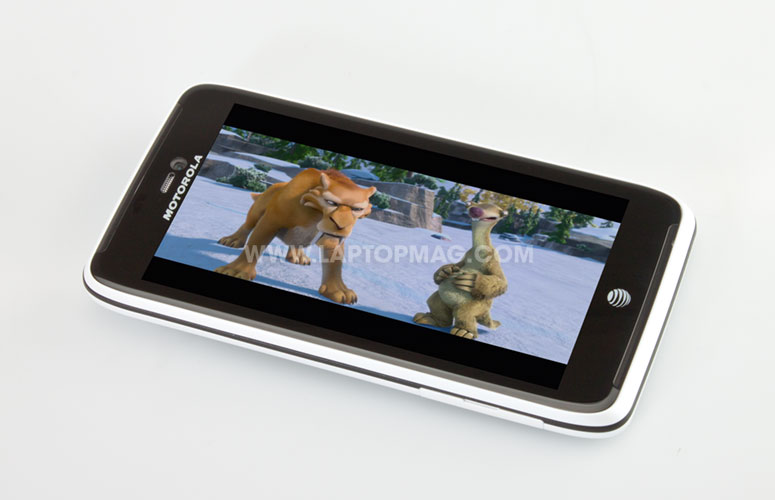
Click to EnlargeThese days, it's not enough just to offer a high-def screen, so Motorola attempts to give the Atrix HD's 4.5-inch 1280 x 720-pixel display an edge with ColorBoost technology. When watching a trailer for "Ice Age: Continental Drift" side by side with the Galaxy S III, the blue sky did pop more on the Atrix, but some of the tropical hues in one scene seemed oversaturated. The S III's AMOLED screen offered better contrast and deeper blacks.
Unlike the S III, however, you won't have a problem reading this phone's display outdoors. The Atrix HD registered a whopping 561 lux on our light meter, which is more than double the Samsung (210 lux) and higher than the Xperia ion (355 lux) and even the HTC One X (525 lux). Viewing angles were also wider than the ion's, though the Atrix kicked back more reflections than the S III.
Just keep in mind that the menu bar at the bottom of the screen makes the display ostensibly smaller. We measured about 4.3 inches.
Audio
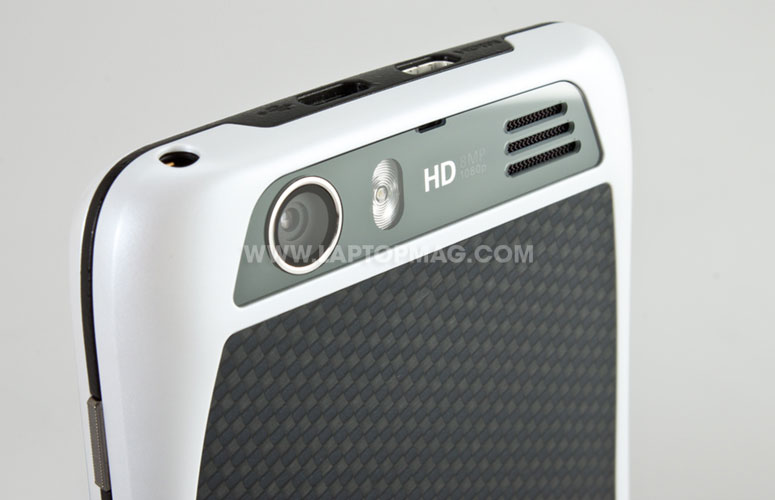
Click to EnlargeYou might want to think twice about investing in a speaker dock for this phone. The Atrix HD's back speaker provided booming audio when we streamed Coldplay's "Paradise" using Pandora. The female voice in Google Voice Navigation was so loud I apologized to a passenger in our car for interrupting.
Software and interface
Motorola's skin on top of Ice Cream Sandwich (no longer called MotoBlur) has a pretty clear sense of purpose: make Android less intimidating. For example, while you have the option of creating seven home screens, you start with one on the left side. As you scroll to the right, you're asked if you want to add a blank page or one designed with a template, such as AT&T Services or Social Networking.
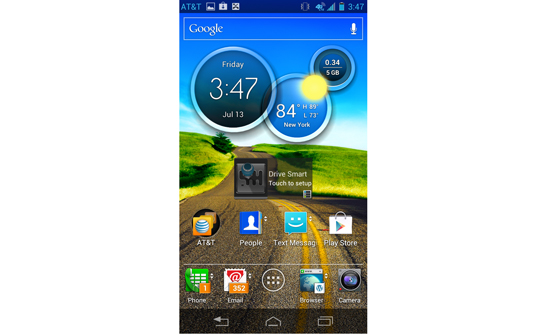
Click to EnlargeWe found this approach fairly intuitive, but found it a little disorienting at first that the main home screen was on the left instead of in the center as on other Android phones. You can easily re-arrange these screens by performing a pinch gesture.
From the lock screen, the Atrix HD lets you launch directly into one of three applications: Phone, Messaging and Camera. Unfortunately, you can't customize these shortcuts. On the plus side, the lock screen also includes a toggle for quickly entering silent mode.
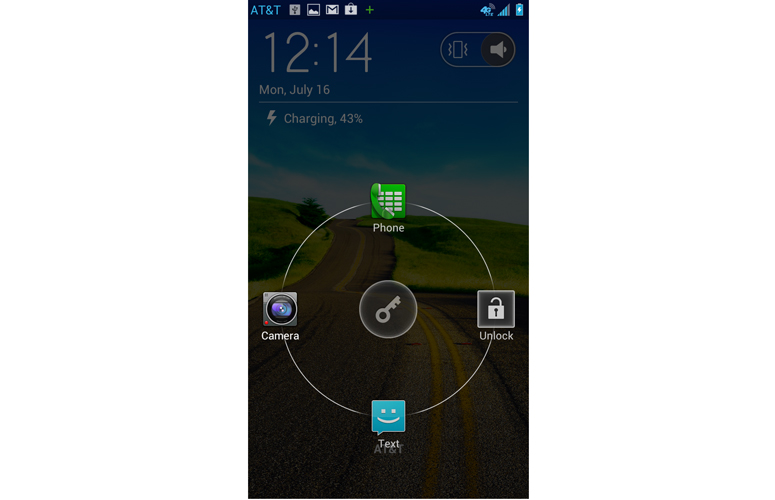
Click to EnlargeThe main home screen includes a new Circle widget that displays the time, temperature and your battery life remaining inside three circles. Swiping on any of the circles displays additional information. For instance, swiping on the battery life meter switches to a view that shows you how much data you've used so far this month.
Another way Motorola tries to save users time is QuickViews, a new view made available to core applications to provide a quick preview. On apps like Email, Phone, People, Browser, Text Message and Calendar, you'll see two small arrows. Swipe up or down on any of these apps and the view will expand to show helpful information without opening the app.
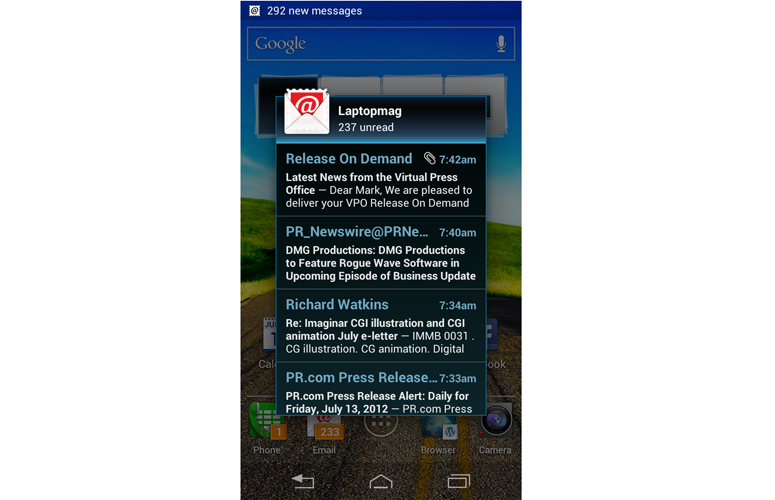
Click to EnlargeFor instance, the Email app QuickView will show you the latest messages in your inbox, similar to a widget. The Browser QuickView displays your bookmarks and the People one displays your favorite contacts. Overall, this a welcome addition to Android and obviates the need for placing and organizing widgets.
Overall, Motorola's UI is user-friendly without being in your face, at the expense of placing some limitations on the stock Android experience.
Keyboard
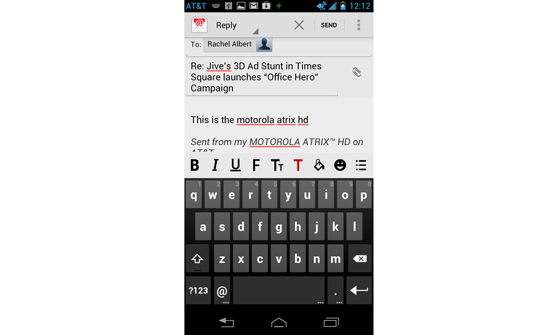
Click to EnlargeAt first, we made a lot of errors using Motorola's keyboard, but once we turned up the Auto Correction from Off to Aggressive, we made less typos. The layout offered light haptic feedback, and we built up pretty good speed after a few days.
You can also engage a separate Swype keyboard for tracing a line between letters to type. This worked well, but thumb typing proved erratic on the Swype layout. We switched back the Moto keyboard.
Performance
The 1.5-GHz Snapdragon dual-core processor inside the Atrix HD is paired with 1GB of RAM to run Android 4.0. In our tests, the phone offered comparable performance to category leaders. In the CPU portion of the Benchmark app, the Atrix HD scored 4,856, which is slightly higher than the AT&T Galaxy S III and just a bit behind the HTC One X (4,885), both of which have the same CPU. The Atrix significantly outperformed the Xperia ion (2,914) on this test, which uses an older 1.5-GHz S3 processor.
Predictably, the Atrix HD turned in comparable scores to the S III and One X on the An3DBench graphics test. It registered 7,214, compared with 7,272 for the Samsung and 7,138 for the HTC. The ion actually notched a higher 7,422.
On the intensive Quadrant test, which measures CPU, Graphics and I/O performance, the Atrix HD scored 4,581, much higher than the ion (3,055) but behind the S III (5,159) and One X (4,901). In this case the Samsung's extra gigabyte of memory probably helped.
In everyday use, the Atrix HD proved snappy for the most part. Apps opened quickly, and we launched into the camera from the lock screen in under two seconds. Moving from one app to the next from the Recent App menu was also pretty fluid. Lag only cropped up only occasionally, but when it did, it was annoying, such as the keyboard taking a second or two to catch up to our taps.
4G and Web Browsing
Click to EnlargeThe Atrix HD offered speedy performance on AT&T 4G LTE network (47 markets and counting). In midtown Manhattan on a bus, we saw between 16 and 19 Mbps downloads and 9 to 13 Mbps uploads. And in our office, the phone offered 7 to 9 Mbps downloads and 9 to 14 Mbps uploads. Both sets of results are within or above AT&T's claims.
Web surfing was plenty speedy. The Atrix HD took 3.8 seconds to load the mobile version of ESPN.com, 3.8 seconds for CNN.com and 4.5 seconds for Yahoo. The full NYTimes site, ads and all, took only 6.8 seconds, and the Laptopmag.com loaded in 13.2 seconds. All of these times are impressive.
Smart Actions and Apps
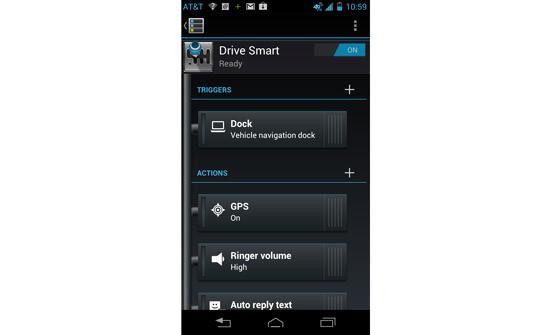
Click to EnlargeMotorola decided to give its webtop software the axe for the Atrix HD, which let previous Atrix phones double as laptops when plugged into an optional docking station. This time around the company kept things simpler, focusing more on Smart Actions.
Smart Actions helps automate some settings that would otherwise require a lot of effort. For instance, a new Drive Smart mode kicks in whenever you place the phone in the optional Vehicle Dock. In this mode, the Atrix HD will send an "I'm driving" auto-reply to text messages and set the ringer to loud.
Other examples of Smart Actions include a Sleep rule for adjusting your ringer at night to a Battery Extender mode that can save juice by doing things such as turning off GPS and background syncing automatically.
Other bundled apps include an Alarm and Timer, Calculator, Vehicle Mode Shortcut and a rudimentary Voice Command app. This app lets you make calls, send texts, look up contacts, send emails and check the status of the battery and other items. However, don't expect Siri- or S Voice-like intelligence. For example, you can say the name of the person you'd like to email from Voice Command, but not dictate the message.
AT&T bundles its usual assortment of apps, most of which users are better off ignoring. AT&T Navigator charges you for something Google gives you for free, and there's AT&T Code Scanner, FamilyMap, and Ready2Go. AT&T Smart Wi-Fi could help you save battery life, though, by automatically connecting you to certain hotspots.
Camera and Camcorder
[sc:video id="RtbjVqcTojU2hrtRnSC5zO-BAAidj-PM" width="640" height="410"]
Click to EnlargeThe 8-megapixel camera inside the Atrix HD offers fairly good performance, starting quickly and snapping shots almost immediately after pressing the shutter button. We only noticed lag when the phone had trouble focusing on the subject. There's a burst mode, but we'd avoid it, since it resulted in a string of blurry photos. While Motorola includes nine special effects for taking pics, we'd prefer to have an HDR mode instead.
Outdoors, images offered delivered good detail and accurate color, such as a shot of a koi pond. However, close-ups lacked the same sharpness; a flower's edges looked somewhat fuzzy, as did surrounding lily pads. Indoor photos with a moderate amount of ambient light also turned out fuzzy unless we engaged the flash.
The Atrix HD's 1080p camcorder delivered satisfying results. Footage of a dog fetching a tennis ball in a pool looked smooth. When the pooch emerged from the water, we could easily make out big drops of water coming off his short fur.
Annoyingly, the Atrix HD doesn't let you make Google Talk video calls over 4G LTE. When we did connect to Wi-Fi, our caller said we looked good, but a little pixilated. Voice came through clearly with minimal latency.
Call Quality and Battery Life
The Atrix HD's loud speaker makes it a good choice for conducting conference calls on the go. Otherwise, voice quality on AT&T's network was reliable on both ends of the line. We had plenty of volume through the earpiece, more than we got through the Galaxy S III.
Our biggest beef with the Atrix HD is its relatively short battery life. In the LAPTOP Battery Test, the phone's 1780 mAh lasted only 4 hours and 52 minutes. This runtime is more than an hour less than the category average (5:55). Other AT&T phones have lasted longer on a charge, such as the Xperia ion (5:58), Galaxy S III (6:28) and HTC One X (5:59).
Verdict
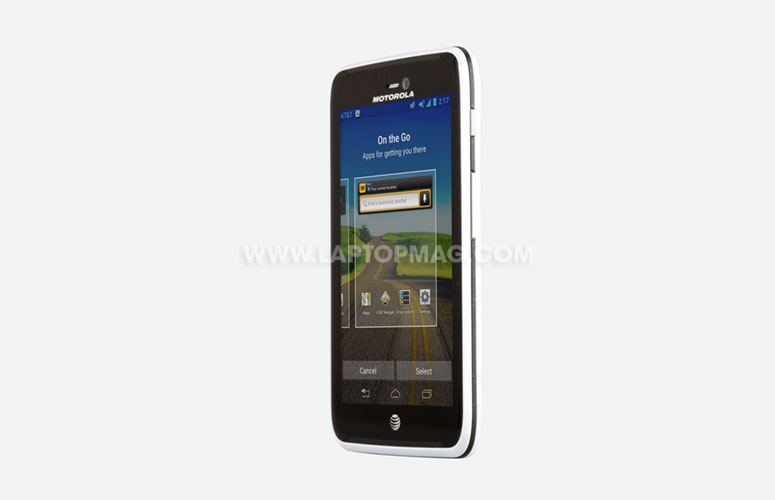
Click to EnlargeThe Motorola Atix HD for AT&T proves that you don't have to spend a bundle to get a high-quality Android phone. This handset's screen is brighter than the Galaxy S III's and you get comparable performance and a sturdier design for $100 less. However, this phone's short battery life is a definite turnoff; Atrix HD owners will definitely want to tweak the settings to squeeze out more juice. In this price range, the $99 Xperia ion offers more built-in entertainment options and a sharper camera, but we prefer the Motorola for its lighter weight and newer Android 4.0 OS. Overall, the Atrix HD is one of the better sub-$100 Android phones available.
Motorola Atrix HD (AT&T) Specs
| Audio formats supported | WAV, MP3, MIDI, AAC+, AAC |
| Bluetooth Type | Bluetooth 4.0 |
| Brand | Motorola |
| CPU | 1.5-GHz dual-core Qualcomm Snapdragon |
| Camera Resolution | 8 MP |
| Carrier | AT&T |
| Company Website | http://www.attwireless.com |
| Data | GSM, WCDMA, LTE, HSDPA |
| Display (main) | 4.5 inches/ 1280 x 720 |
| Form Factor | Candybar Touchscreen |
| Front Camera Resolution | 1.3MP |
| GPS | Yes |
| Internal Memory | 8GB |
| Memory Expansion Type | microSD Card |
| Networks | WCDMA 1900/850/2100/1700, GSM 1900/850/900/1800, LTE Band 04/Band 17, HSDPA 21.1 Mbps (Category 14), HSUPA 5.76 Mbps |
| Operating System | Android 4.0 |
| Ports | microUSB, 3.5mm headphone |
| RAM | 1GB |
| Size | 5.3 x 2.8 x 0.33 inches |
| Talk / Standby Time | 9 hours/8.5 days |
| Weight | 4.9 ounces |
| Wi-Fi | 802.11 a/b/g/n |

